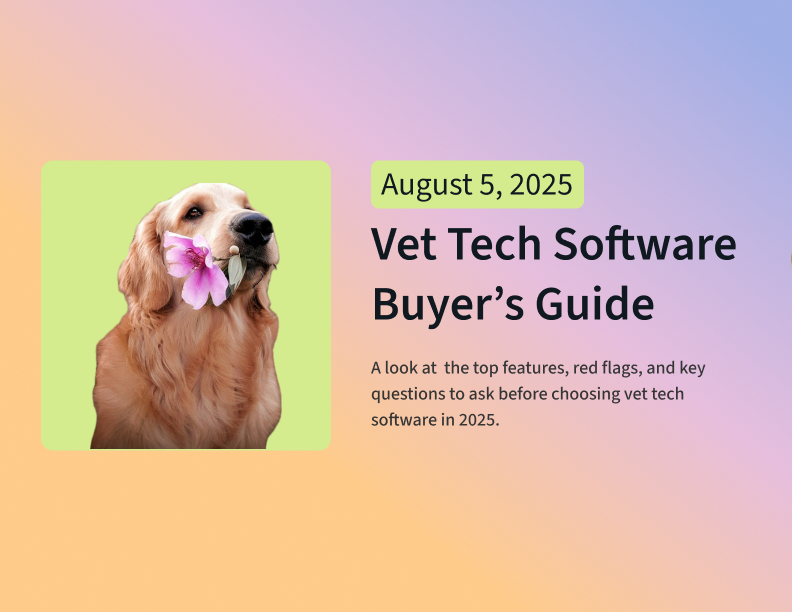In 2025, veterinary clinics are more digitally connected than ever. Whether you're running a solo practice or managing a multi-location hospital, choosing the right vet tech software can make or break your clinic’s efficiency, client satisfaction, and bottom line.
But with dozens of platforms on the market, what features actually matter? To uncover the most important vet tech features of 2025, Vetspire partnered with INSIGHT2Profit to conduct in-depth research, including comprehensive interviews with industry stakeholders and a voice-of-customer survey.
This 2025 Buyer’s Guide will walk you through the findings of the most essential features, must-ask questions, and red flags to avoid when selecting vet tech software that truly supports your team and patients.
What Is Vet Tech Software?
Vet tech software refers to digital tools that help veterinary technicians and clinic teams manage patient care, streamline operations, and improve communication across the clinic.
It’s often part of a broader Veterinary Practice Management System (PIMS), but not all vet tech software is created equally.
Key Vet Tech Features to Look For in 2025
Here are the must-have features for any vet tech software worth your investment, along with our key survey data.
Robust Medical Records
A majority 79% of veterinary professionals consider medical records a must-have feature. Medical records should be intuitive, real-time, and accessible from any device.
Top capabilities to look for:
- Drag-and-drop SOAP notes
- In-room updates
- Searchable patient history
- Auto-sync with lab results and imaging
AI That Augments, Not Replaces
In 2025, AI is everywhere, and 58% of survey respondents insist it is a must-have feature. When evaluating AI solutions, here is what to look for:
- True integration into your medical records, so you don’t have to copy and paste
- Scribe features that record conversations and auto-generates SOAP notes in real-time
- Summary features that can access the most relevant patient details at a glance, including recent visits, medications allergies, and pre-existing conditions
- PDF summarization abilities for instant clarity from uploaded records
Intelligent Workflow Automation
63% of veterinary professionals agree this is essential. Modern software should automate repetitive tasks:
- Medical record documentation
- Appointment reminders
- Follow-up scheduling
- Digital consent forms
Look for: AI-powered automation that adapts to your clinic’s needs — not just generic task lists.
Integrated Calendar & Scheduling Tools
Your team needs to manage patient flow efficiently, and 79% of our survey respondents agree. A centralized, smart calendar helps eliminate chaos.
Key features to look for:
- Color-coded appointment types
- Drag-and-drop rescheduling
- Multi-doctor and multi-location support
- Real-time updates across devices
Client Communication Tools
Client retention is built on communication. 67% of veterinary professionals say that communication features are a must. Choose software that supports:
- Two-way texting and email
- Appointment confirmations
- Post-visit instructions
- Mobile app access for pet parents
Inventory Management
Smart inventory management can have a huge impact on your clinic’s overall business outcomes. In fact, 71% of our survey respondents said good inventory management is a must. Make sure the inventory management:
- Monitors current stock levels of medications, vaccines, pet food, and supplies
- Alerts you when items fall below reorder thresholds
- Provides reports on inventory turnover and slow-moving stock
Other Considerations When Evaluating Veterinary Technology
In addition to the features that are included with a PIMS system, you should also consider a user-friendly and cloud-based solution. Here’s why.
User Experience That Works for Veterinarians
Look for a software that is intuitive and easy-to-use. This will reduce admin time and training time for new staff members. Prioritize:
- Quick navigation during appointments
- Voice-to-text functionality
- Minimal clicks to complete tasks
Cloud-Based & Mobile-First
In 2025, cloud-first software is no longer optional. Your clinicians need to access records, update notes, or manage tasks on the go, whether in exam rooms or curbside. Also, you never want updating medical records to keep your staff from having dinner with their families.
Look for a veterinary software solution with browser-accessible dashboards and mobile optimization.
Red Flags to Avoid in Vet Tech Software
- Outdated UI: Clunky, slow interfaces frustrate staff and slow down care.
- No mobile access: Limits flexibility for techs and field teams.
- Limited support: If training or customer support is hard to reach, onboarding will be painful.
- Remote-only onboarding: If a veterinary software is able to travel to you to help support veterinary software implementation, it is usually a much more seamless experience.
- Data silos: Avoid software that doesn't integrate with labs, imaging, or accounting tools.
Questions to Ask Before Choosing a Veterinary Software Solution
- Can our whole team (including techs) try a demo?
- Does this software integrate with our lab and payment systems?
- How long is onboarding and is training included?
- What does support look like?
- How often is the software updated or improved?
Why the Right Vet Tech Software Matters
The right platform:
- Empowers vet techs and veterinarians to focus on patient care
- Reduces human error
- Increases compliance and revenue
- Improves morale and staff retention
- Saves time and allows you to see more patients
With veterinary burnout at an all-time high, great software isn’t a luxury, it’s essential.
️Vetspire is Built with Clinicians in Mind
Vetspire is more than just a PIMS, it’s a powerful vet tech software platform designed to support clinical workflows, patient care, and team collaboration. From AI-driven medical records to integrated communication tools, Vetspire helps your clinic work smarter, not harder.
See it in action → Schedule a demo
Final Thoughts
Choosing the right vet tech software in 2025 means looking beyond the basics. Your team is the backbone of patient care, so give them tools that work with them, not against them.
By prioritizing automation, cloud access, and user-friendly design, you can future-proof your clinic and deliver exceptional care.
